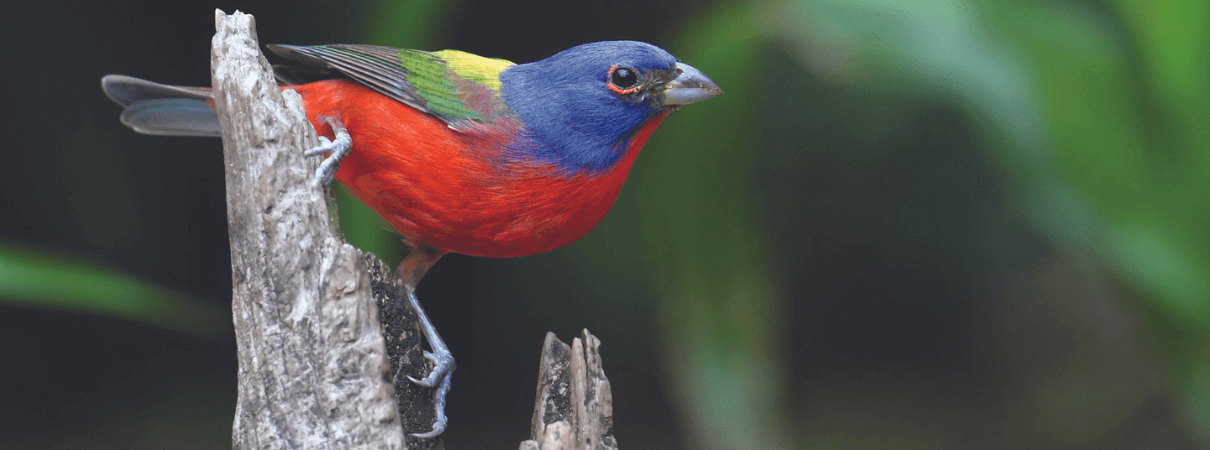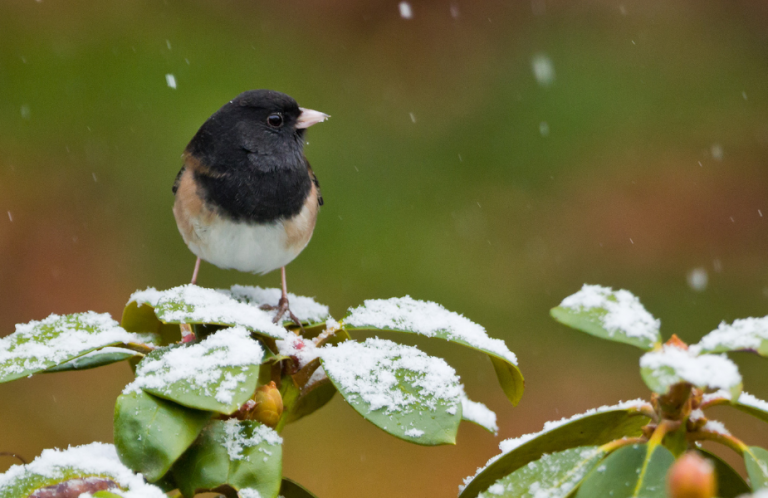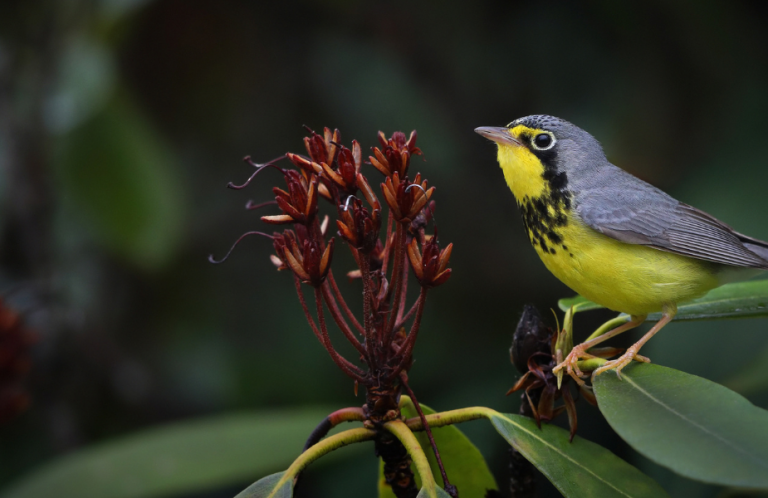The Eastern Painted Bunting: Flashy Colors, Mixed Fortunes
No North American songbird is more strikingly colored than the male Painted Bunting. With its blue head, red underparts, and yellow-green back, this bird turns heads whenever one pops into view. You might think that such a dazzling creature, so beloved by birdwatchers, would be carefully studied and monitored, with ornithologists and conservation biologists keeping a close eye on any potential threats.
Although the bunting's smaller eastern population has received attention in recent years, many details of its conservation status remain murky. What is known paints a topsy-turvy picture of changing status, with a positive twist: Following years of decline, a consensus has emerged that eastern Painted Buntings seem to be doing better than once believed, at least for now.
The Painted Bunting is split into two geographically isolated populations. One breeds across a wide swath of the south-central United States and in Northern Mexico, with a range encompassing all or almost all of Texas, Oklahoma, Louisiana, and Arkansas, and parts of Mississippi, Kansas, and Missouri. The much smaller eastern population occurs along a narrow strip of the Atlantic Coast, from northeastern Florida north to eastern North Carolina.

Are these two populations distinct subspecies? This designation remains to be made, but those arguing for subspecies status point out that the most recent genetic analysis shows little or no gene flow between the populations for at least the last 26,000 years. Plus, western breeders spend the winter in Mexico and Central America, while eastern breeders migrate mainly to Cuba, the Bahamas, and Florida's lower half.
Both Painted Bunting populations nest in shrubby and woodland habitat interspersed with open areas — nowhere with too many trees, but not in open grassland, either. For eastern, coastal-nesting birds, this typically means behind the dunes but not so far back that they're in dense maritime forest — in the sweet spot where the once-shifting sand has been stabilized by vegetation but the habitat has not yet been completely taken over by trees. Abandoned farm fields and other overgrown but still unforested places can also provide bunting habitat.
For a long time, these eastern birds, which have a breeding range occupying only about 4 percent of that covered by the western population, appeared to be in trouble. Data from the Breeding Bird Survey (BBS), an annual survey of bird populations conducted by volunteers following the same established roadside routes year after year, shows that the eastern Painted Bunting population declined at a rate of around 3 percent per year during the latter decades of the 20th century. There's likely no single “smoking gun” behind the observed decline. Dean Demarest, a senior biologist with the U.S. Fish and Wildlife Service's (FWS's) migratory bird program, described it as “death by a thousand cuts.”

A few threats do stand out, though. Although they visit feeders, these birds do not nest in manicured suburbs or cities, but in wild places offering abundant shelter as well as plentiful seeds and insects, which provide important protein for their fast-growing young. The eastern Painted Bunting's limited range and affinity for prime coastal real estate, where the brush they nest in is often cleared to make way for new roads and buildings, makes them especially vulnerable to habitat loss. Retired United States Geological Survey biologist Paul Sykes, who studied eastern Painted Buntings for 20 years, recalls seeing them vanish from some of his study sites over time as the surrounding habitat changed. “A lot of times the surrounding area got modified in some fashion by development,” he says.
Painted Buntings' beauty also makes them a target. Illegal trapping of live birds to sell as pets has long been rampant in parts of their wintering range, including in South Florida.
A Fresh Eye on Breeding Buntings
BBS routes don't cover the core habitat of eastern Painted Buntings well, and while BBS data can provide an idea about a population's trend — whether it's increasing or decreasing — it's less useful for estimating abundance, the actual number of birds out there at any given time. Around 2004, staffers from the FWS, the Atlantic Coast Joint Venture (of which ABC is a part), and other organizations came together to form the Eastern Painted Bunting Working Group, with the goal of getting a better handle on how the population was really doing and the type of conservation action that might be needed. The working group initiated a new survey, hoping to cover the eastern population's entire range and to get a clear picture of its distribution, density, and abundance.
From 2007 to 2009, biologists from federal and state agencies throughout the eastern population's range conducted point counts, recording how many birds were seen or heard at points along new routes selected to better cover areas where buntings were likely to be found. At the same time, a community science effort led by the University of North Carolina Wilmington's Jamie Rotenberg recruited amateur birdwatchers to submit data on Painted Buntings visiting feeders.
The survey found a lot of buntings — especially in the upper coastal plain of Georgia and North Carolina, a largely overlooked area inland from the coastal scrub habitat traditionally thought of as the population's stronghold. “We concluded that there were at least as many birds as some of the other estimates at the time [had shown], but possibly twice as many, if not more,” says Demarest, a key organizer of the working group.

Not only did it look like eastern Painted Buntings were more common than anyone had thought, but the concerning downward trend that had helped spur the formation of the working group also seemed to have come to a halt around the same time. Since the early 2000s, BBS results for eastern Painted Buntings show a turnaround, with the number of buntings spotted on BBS survey routes in the region beginning to increase slightly. And the population may be expanding its range northward and westward as well. In 2017, a pair apparently nested on the coast of Virginia, a first for the state.
So is the eastern Painted Bunting out of the woods? It's unclear. For one thing, not every researcher I spoke to puts much faith in the increasing BBS numbers. While some thought that a trend that appears consistent over so many years must be real, others remained skeptical due to the poor coverage of bunting habitat.
If the eastern Painted Bunting has truly started to increase after decades of decline, the reason remains a mystery. This is especially vexing because none of the threats that ornithologists had guessed might be behind the population's downward slide have gone away. Coastal development in the eastern Painted Bunting's breeding range certainly hasn't stopped. “I can guarantee you there's not more habitat” than there used to be, says Demarest.
The illegal bird trade hasn't halted, either, though it's nearly impossible to know for sure if enough birds are being captured to have a population-level effect. “Particularly when the trade is illegal and birds are being sold and caught illicitly, the volume of the trade is extremely hard to quantify,” says John C. Mittermeier, ABC's Director of Threatened Species Outreach. “This is especially true when the market for a bird species is a domestic one, since international export and import data is often one of the only ways to get numbers on wildlife trade.”

The Florida Fish and Wildlife Conservation Commission has stepped up enforcement efforts against the trapping of songbirds in recent years, including introducing a new rule in 2019 that made even possessing an unpermitted trap punishable by a $500 fine or up to 60 days in jail. However, Florida officials still estimate that thousands of Painted and related Indigo Buntings are illegally trapped in the state each year.
In Cuba, where songbird trapping is also illegal but enforcement is almost nonexistent, the problem is likely worse. To study the bird's migration, University of Georgia's Clark Rushing (formerly at Utah State University, where he carried out the research described here) has deployed almost 300 tracking devices called light-level geolocators on Painted Buntings from across the eastern population's range. These tiny devices record sunrise and sunset times at a bird's current location, which are used to estimate latitude and longitude. An analysis Rushing and his colleagues published in the journal Ornithological Applications in spring 2021 shows that male buntings that winter in Cuba are 20 percent less likely to return to their breeding grounds the following season than birds wintering elsewhere in their wintering range, primarily in the Bahamas and central and southern Florida.
“Of course, we don't know that it's the pet trade,” says Rushing. “It could be that those [birds] have to migrate farther, or that there are other threats in Cuba. But it's certainly consistent with the idea that the pet trade is a problem.” At one point during his study, Rushing got word from a contact in Cuba that a couple of buntings wearing “weird little devices on their backs” had been captured by illegal trappers there. The devices were Rushing's geolocators.
Why, then, is the eastern Painted Bunting population (maybe) on the rise? “For the life of me, I can't tell you,” says Dean Demarest. “It's a mystery.”
READ MORE: Western Painted Buntings Benefit from Expanding GRIP
The bird conservation network Partners in Flight estimates that there are 15 million breeding Painted Buntings across the species' entire breeding range, from the southern United States into Northern Mexico. Almost half of them nest in the area covered by the Oaks and Prairies Joint Venture (OPJV), an ABC-supported bird conservation partnership that conserves habitat in central Texas and central Oklahoma.
In 2013, the OPJV, which includes governmental and nongovernmental partners as well as many private landowners, land managers, and birders, initiated the Grassland Restoration Incentive Program, or GRIP. This program incentivizes property owners in the region to introduce practices such as prescribed burning and planting native grasses on their lands. Land management practices such as these benefit a suite of grassland and shrubland birds — including Painted Buntings.
“We provide technical guidance [to landowners] and give them information on what might work with their land management objectives,” says former OPJV Coordinator Jim Giocomo, who is now ABC's Central Region Director. “And then to get them over the hump and provide a little bit of training wheels, we can provide incentive payments to implement these new types of practices.” Landowners in the program commit to maintaining the resulting bird habitat conditions on their property for at least five years. Prescribed burning, in particular, helps keep trees at bay and creates the shrubby habitat that Painted Buntings seek. Other species with declining populations that benefit from this OPJV effort include the Dickcissel, Eastern Meadowlark, Northern Bobwhite, and about one-third of the wintering population of the LeConte's Sparrow.
So far, GRIP has enrolled 110,000 acres. OPJV's long-term goal is to reach 3 million. “We're getting there,” says Giocomo, “and if we hadn't started in 2013, we wouldn't be where we are now.”
Into the Future
Indeed, there is still much we need to learn about the eastern Painted Bunting. When I asked Demarest whether climate change could be playing a role in what's going on with this iconic bird, he pointed out that more frequent hurricanes would be more likely to create the open, shrubby habitat buntings seek than to destroy it. I quipped that maybe that's why the birds are potentially increasing, and he couldn't entirely rule out the idea. In its climate modeling, the National Audubon Society indicates that the Painted Bunting is a species that would likely undergo a northward range expansion under various warming scenarios.

“I am still somewhat surprised at how little work has been done on this species,” says Clark Rushing, the geolocator researcher. “First, because they're really interesting from an ecological perspective, and second, because people love 'em, which I think lends itself to people getting excited about the research.”
While conservationists recognize that habitat loss and illegal bird trade are dangers to this bird, Demarest still worries that wildlife managers could be missing some key threat to the species while their attention is elsewhere. “You know, you're chasing all the critters that are in really dire straits, and so you forget about the Painted Buntings,” he says. “Then 20 years from now, someone goes, ‘Hey, have you seen what's happened to Painted Buntings lately?'”
The popular community science platform eBird will be releasing its own trend data on Painted Buntings soon, which may help clarify how worried about them (or not) we should be. With so many birdwatchers keeping their eyes peeled, it seems unlikely that such a stunning rainbow of a bird will ever truly be forgotten for long.
 | Rebecca Heisman, a freelance science writer based in Walla Walla, Washington, is writing a book on the history of bird migration research, due to be published in spring 2023. She can be reached at @r_heisman on Twitter, or via her website rebeccaheisman.com. |


















































